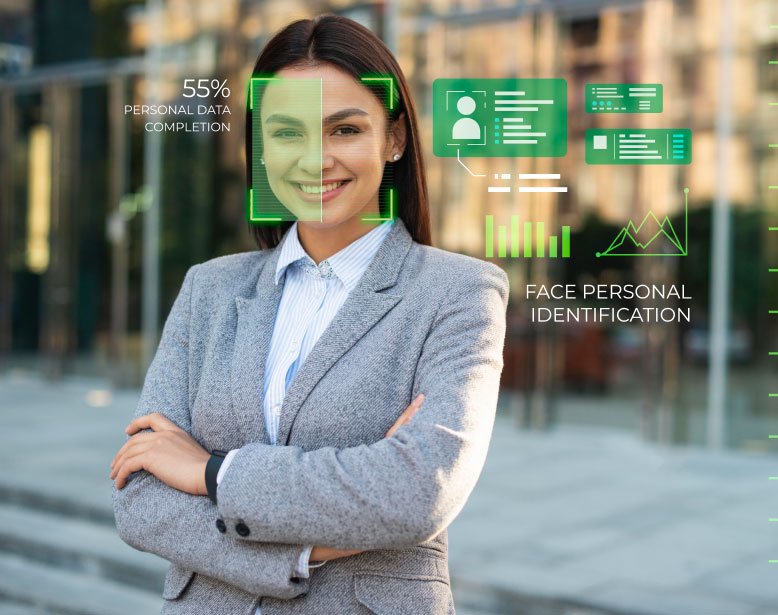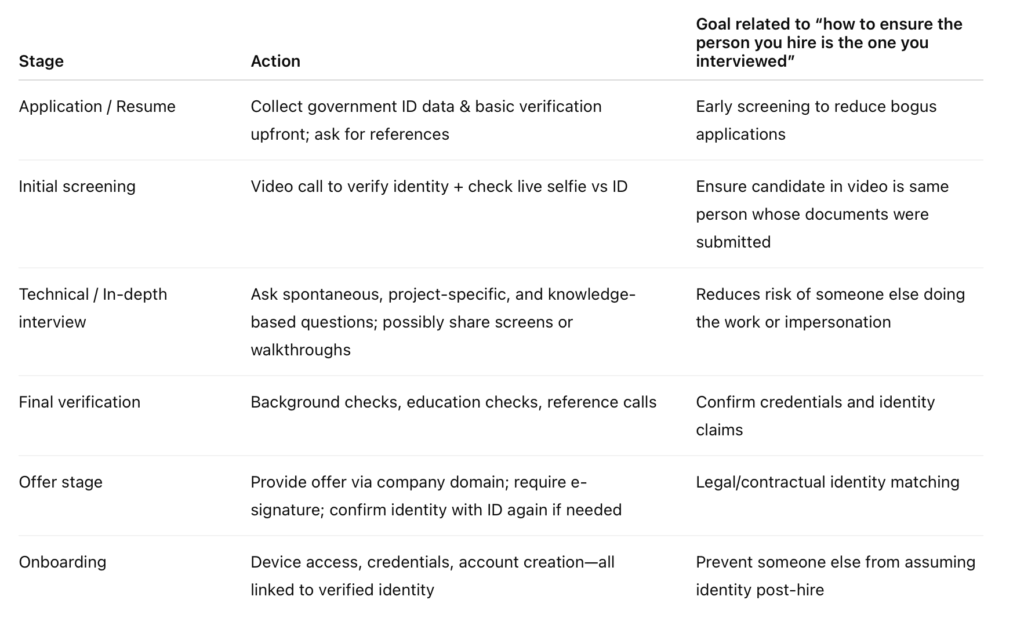October 6, 2025

Software Development Outsourcing, Staff Augmentation
How to Ensure the Person You Hire Is the One You Interviewed
How to Ensure the Person You Hire Is the One You Interviewed. Hiring remotely is now common practice. But with remote hiring comes greater risk: fraud, impersonation, fake credentials, or in some cases someone other than the person who interviewed shows up to do the work.
In this post, we explore deeply how to ensure the person you hire is the one you interviewed, why it matters, what the risks are, and what you can do (step by step) to reduce that risk dramatically.
Why it Matters: The Stakes Are High
Before jumping into what you should do, let’s examine the risks and how big this problem is.
According to HireRight’s 2025 Global Benchmark Report, only 60% of global employers conduct identity checks in pre-employment screening. techintelpro.com
One in six organizations reported experiencing identity fraud during hiring; many others aren’t sure if they did. techintelpro.com
Over 75% of employers uncovered candidate discrepancies in the past 12 months — e.g. mismatches between what was on the resume vs. what was found in verifications. techintelpro.com
Gartner predicts that by 2028, 1 in 4 candidate profiles globally may be fake. HR Dive
These numbers show that it is not rare or hypothetical: misrepresentation is happening now. That means every time you hire, there is a non-trivial risk that the person you hire is not the one you interviewed.
It could be someone else impersonating, or someone exaggerating, or credentials being forged.
Common Scenarios Where Identity Mismatch Happens
To better understand what you’re protecting against, here are some real or documented cases:
1. A candidate submits a resume, passes an interview, but when it comes to work (or access to systems), it emerges that credentials were falsified.
2. In remote hiring, someone else may appear in an interview or take part in video calls, but not be the person who will perform the work.
3. Deepfake or manipulated video or voice recordings are used in video interview rounds. Biometric Update+1
4. Identity theft schemes: for example, North Korean operatives used stolen identities to appear as U.S. citizens and get remote tech jobs at U.S. companies. Axios+1
These situations damage team trust, productivity, possibly security, and may even involve legal or compliance risk depending on the role and data access.
What Drives the Problem
What has changed such that how to ensure the person you hire is the one you interviewed has become a critical question?
- Remote work normality
The growth of remote work opens more opportunity for fraud, because in-person verification is harder. Video interviews, asynchronous assessments, etc., reduce physical cues.
- Advances in identity manipulation tools
Tools exist now that allow people to fake identities more convincingly: doctored credentials, AI-generated faces, deepfake videos. Biometric Update+1
- High volume of applicants
When hiring at scale, screening many candidates means less time per candidate, increasing the chance that fake or impersonating candidates get through.
- Pressure on hires
Companies are under pressure to hire fast. That increases risk of cutting corners in vetting or verification.
- Limited standardization of verification practices
Many employers do some checks; fewer do strong, multi-factor verification. Checks are inconsistent. techintelpro.com+1
How to Ensure the Person You Hire Is the One You Interviewed
Now, key part: what to do. Here are proven methods, tools, and processes you can put in place so that when you hire someone, you can be confident the person who shows up for work is the same person you interviewed.
These practices relate directly to how to ensure the person you hire is the one you interviewed — repeat for clarity.
1. Identity verification via official documents + live/biometric checks
- Ask candidates to provide official government-issued ID (passport, driver’s license, national ID) and verify key fields (name, photo, expiry, issuer).
- Use selfie verification with liveness detection: the candidate sends a selfie or joins a video call and shows their ID, then takes a photo or does a “selfie” in real time. Some tools check that the person in the ID matches the person in the camera and that the live person is present (not just a photo). Persona+2Idenfo Direct Mena+2
2. Use Video Interviews with “Face to Face” human verification
- Require video interviews as part of the hiring process; ensure the person interviewed is the same person whose ID got verified.
- During the video interview, use unscripted parts, ask spontaneous questions about experiences, ask them to present something physical (e.g. show a piece of ID, show a background item, share their screen) to observe authenticity.
- For finalists, conduct a video meeting where camera is on and verify identity live. Incode+1
3. Background checks and reference verification
- Contact previous employers or references listed by the candidate. Ask detailed, specific questions. Were they really in that role, what projects did they work on, did their performance match resume claims?
- Verify education: contact institutions, check transcripts or degree documentation.
4. Use secure and centralized communication channels
- Conduct official communication (offers, interviews, identity document exchange) via company-verified email domains or secure candidate platforms (not just WhatsApp or arbitrary messaging apps).
- Keep records of offers, interviews, and identity verifications.
5. Multi-factor / layered identity assurance
- Combine different verification methods: ID + video + reference + in some cases biometric / liveness detection. More than one check reduces risk. Verifik+1}
- Use knowledge-based authentication: check things only the candidate should know (past employer, dates, specific project details).
6. Use identity verification tools and platforms
- There are platforms (e.g. identity verification services) that cross-check IDs against government or trusted databases. Persona+2evalid.io+2
- Tools that help detect manipulated documents, watermarks, tampering. Idenfo Direct Mena
7. Monitor for red flags
Some warning signs that the person interviewing may not be who they say they are:
- Candidate avoids showing their face in video, uses filters or static background, or refuses to turn on camera.
- Inconsistent or vague responses about prior experience.
- Resume claims not matching references or online presence.
- Sudden changes: different person in subsequent interview rounds, or someone else taking over identity.
8. Onboarding verification
- When onboarding, require that workplace credentials (email, devices, access) match the identity verified.
- If possible, in certain roles, require in-office verification or identity checks in person.
Putting It All Together: A Process Flow
To embed how to ensure the person you hire is the one you interviewed into your hiring pipeline, here is a suggested process flow. You can adapt to your company size, remote vs in-office, and roles.

Data & Statistics Supporting Why These Steps Matter
More evidence to show this isn’t just “best practice” but necessary.
- In the Checkr “Hiring Hoax” survey (2025), 31% of managers said they interviewed a candidate later revealed to be using a fake identity. Checkr
- The same survey: 35% report someone other than the listed applicant participated in a virtual interview. Checkr
- From HireRight: over 75% of organizations found at least one discrepancy in their candidate screening in the past year. techintelpro.com
- In identity fraud rates by region, Asia-Pacific saw about 20%, followed by EMEA and North America lower but still significant (~15%) for identity fraud in hiring. HCAMag
These data points make it clear: identity mismatch isn’t edge case. It is significant, increasing, and likely to grow.
Challenges & Trade-Offs
While you want to secure hiring, some trade-offs and challenges come with digging deeper into identity verification.
- Candidate experience friction: too many checks can delay hiring or dissuade high-quality candidates.
- Privacy & compliance concerns: handling identity documents, biometric data, photo IDs, etc., must follow local law (GDPR, data protection, etc.).
- Operational cost & tool acquisition: using third-party identity verification tools or paying for background checks adds cost.
- False negatives / false positives: some legitimate candidates may fail certain identity or document checks due to technical / formatting issues.
You must balance thoroughness with respect, speed, transparency, and compliance.
Action Plan
Here are concrete steps you can implement at your organization starting now. These directly tie to how to ensure the person you hire is the one you interviewed:
Define an Identity Verification Policy
- Decide which roles require full verification vs lighter verification.
- Define what documents are acceptable, what counts as acceptable ID.
- Define how many verification steps are required (e.g. ID + video + reference).
Select Tools & Platforms
- Choose one or more identity verification services (for document checks, biometric matching).
- Consider background check providers, education verification services.
- Integrate tools into your ATS (applicant tracking system) to automate or streamline verification.
Train Interviewers & HR Staff
- Teach them red flags, how to handle identity verification, how to spot document forgeries, unnatural behavior in video interviews.
- Include unscripted parts in interviews, unexpected questions.
Embed Verification Early in the Process
- Do identity checks as early as possible (e.g. after passing initial screening but before deep technical commitments).
- Use live video where possible.
Standardize Onboarding to Confirm Identity
- Require confirmed ID, consistent photo, etc., before giving system access.
- If possible, in certain roles, arrange for in-person verification or notarization.
Monitor and Audit
- Review cases where something felt off. Document lessons learned.
- Audit hires annually for any identity issues or discrepancies.
Communicate with Candidates
- Let candidates know why full identity verification is part of your process. Transparency improves trust.
- Be considerate of privacy concerns; provide secure channels to upload IDs, etc.
Real-World Example: A Case from Remote Hiring
Here’s a real example that illustrates why how to ensure the person you hire is the one you interviewed matters in practice:
- Justice Department uncovered a scheme: thousands of remote IT workers (North Korean) used stolen identities to secure remote jobs with major U.S. companies. Axios
- In many remote hiring situations, the person interviewed was not physically present; the fake identity was used to perform work under a false avatar.
This kind of fraud can lead to reputational damage, security breaches, and misallocated salary or payments.
Conclusion
Ensuring the person you hire is the one you interviewed is not just a matter of due diligence-it’s a necessary safeguard in modern hiring, especially remote. Fraud, identity mismatch, deepfake manipulation, and resume inflation are real and growing threats.
By incorporating multiple verification steps, official ID checks, facial verification, video interview with live parts, reference checks, and solid onboarding, you protect your organization, your data, and your team.
Start today: define your identity verification policy, select tools, train your team. Each hire that sheet of verification prevents might save you far more than you invest.
Ready to take the next step?
Book a meeting now we combine technology, compliance, and human validation to protect your hiring process and help you build teams you can trust.
Learn about: The Changing Economics of the H-1B Visa here









